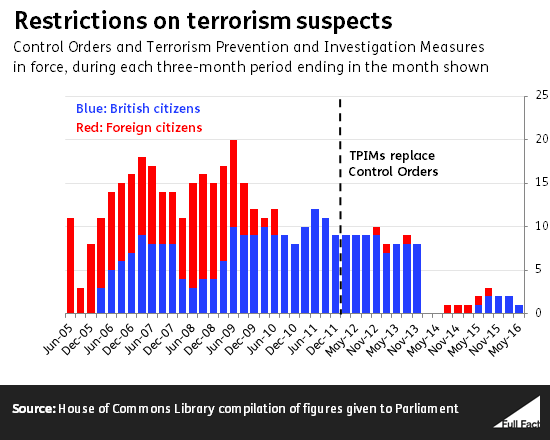“2,000 terror suspects in UK but only one is under a curfew”
Daily Mail, 28 July 2016
It’s correct that, earlier this year, only one person in Great Britain had restrictions on his or her daily life because that person was suspected of terrorism-related activity. But that’s not a new development.
Honesty in public debate matters
You can help us take action – and get our regular free email
Terrorism Prevention and Investigation Measures
The Mail’s story cites a “statement slipped out to Parliament just before the summer recess” as the source for the figure that there was only one terror suspect under curfew.
It’s available here. The Minister of State for Security, John Hayes, did report on 14 July that there was one Terrorism Prevention and Investigation Measure (TPIM) in force on 31 May 2016.
That wasn’t an exceptional situation. The Mail is correct that there were nine people affected by TPIMs in 2013, but since then there have never been more than three in a given quarter. In early 2014, no TPIMs were in force at all.
 TPIMs are orders made by the Home Secretary under a law passed in 2011. They place various restrictions on where people can go and what they can do. These can include ordering them to stay in a particular place overnight – in effect, a curfew.
TPIMs are orders made by the Home Secretary under a law passed in 2011. They place various restrictions on where people can go and what they can do. These can include ordering them to stay in a particular place overnight – in effect, a curfew.
It’s possible that the intelligence services see TPIMS as less useful than the more restrictive Control Orders that they came in to replace. The authorities can also monitor suspects without them.
“In practice TPIMs may be withering on the vine as a counter-terrorism tool of practical utility”, a committee of MPs and Lords reported in January 2014. This conclusion was at least partly endorsed by the Independent Reviewer of Terrorism Legislation, David Anderson QC, in March 2015, although he also said that the orders could be effective and had been improved over the years.
The government made changes to TPIMs in 2015 and expected between 5 and 15 extra cases a year as a result, but these don’t seem to have materialised.
TPIMs can be imposed for up to two years as a “last resort” to protect the public from people “whom it is feasible neither to prosecute nor to deport”, in the words of Mr Anderson.
They are only allowed if the Home Secretary “is satisfied, on the balance of probabilities, that the individual is, or has been, involved in terrorism-related activity” – along with four other conditions.
The number of terrorism suspects
There are 2,000 people on the “radar” of the security services, according to former counter-terrorism official Chris Phillips.
They may not all satisfy the conditions for being put under a TPIM. In any event, Mr Phillips himself thinks that monitoring 2,000 people around the clock would be impossible.
An alternative figure of 3,000 suspects has been widely reported by newspapers, citing security sources.
So far as we know, there are no official figures on terrorism suspects.
We do know that in the 12 months to March 2016, the police used their powers under terrorism laws to stop and question travellers at ports and airports over 26,000 times. There were 255 “terrorism-related arrests”, 51 prosecutions for terrorism offences, and 47 convictions.
